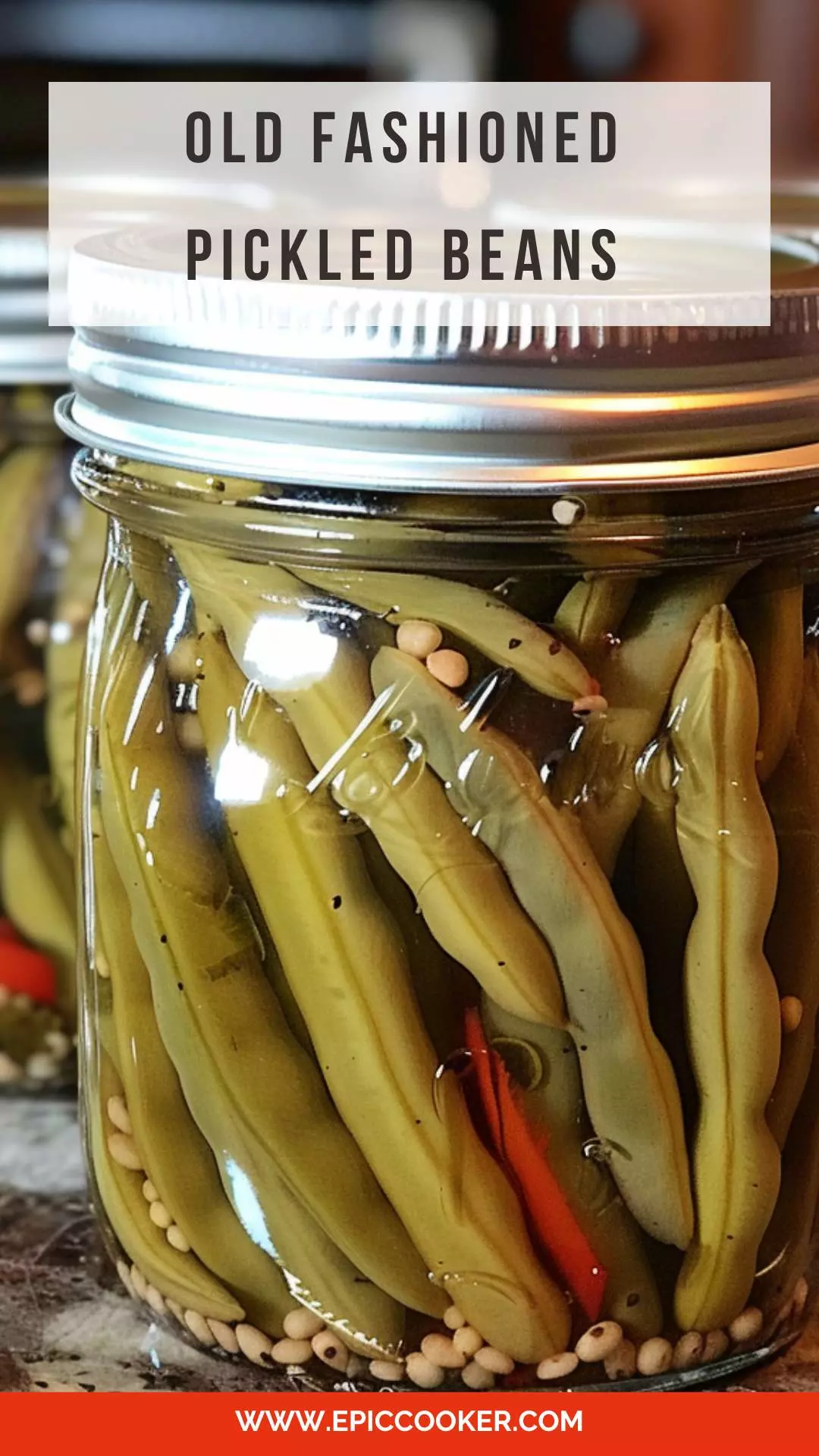As I delve into the treasure trove of classic recipes, I came across a forgotten gem – old-fashioned pickled beans. These tangy, crunchy delights have been a beloved part of our culinary heritage for generations.
Join me on a gastronomic adventure as we explore the rich history, unique flavor profile, and the secrets behind making the perfect old-fashioned pickled beans.
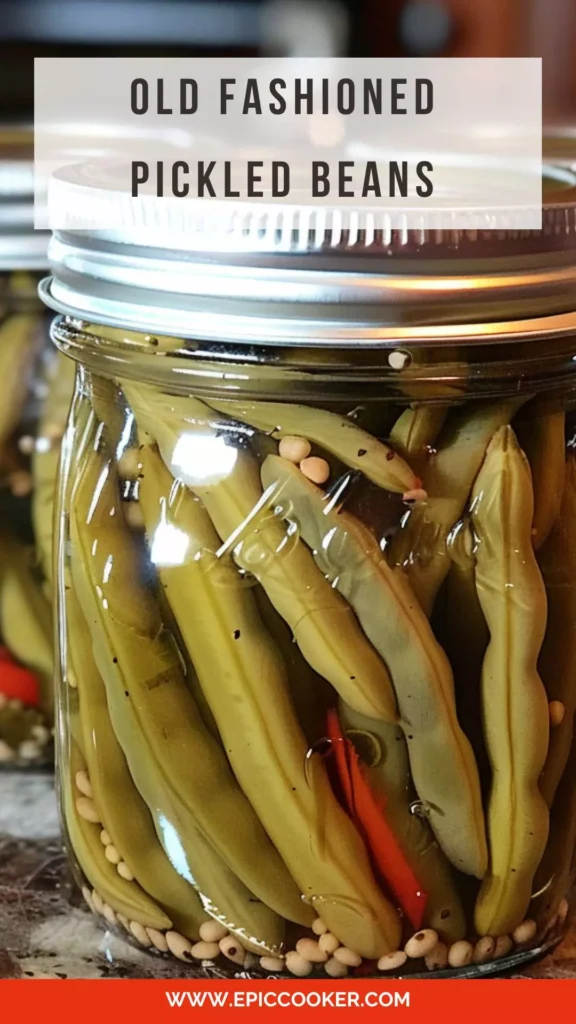
What is old fashioned pickled beans?
Old-fashioned pickled beans, also known as dilly beans, are a traditional preserving method for green beans. Unlike the popular pickled cucumbers, these beans offer a delightful twist to your taste buds.
The beans are brined with a vinegar-based mixture and infused with garlic, dill, and a subtle hint of red pepper flakes for those who desire a bit of extra heat.
What is the flavor profile of this dish?
The flavor profile of old-fashioned pickled beans is truly remarkable. With a pleasing balance of tanginess, sweetness, and earthiness, every crisp bite offers a burst of delightful flavors.
The vinegar provides tangy notes, while the dill and garlic bring a subtle herbal freshness. Adding a touch of red pepper flakes introduces a slight kick that intensifies the overall experience.
What Makes This Recipe Different From Other old fashioned pickled beans?
While old-fashioned pickled beans may seem similar to other pickled recipes, it is the combination of ingredients and the traditional preservation method that sets it apart.
The infusion of dill and garlic adds a unique flavor dimension, resulting in a rich taste profile. Additionally, the red pepper flakes offer a gentle heat that elevates the overall experience without overpowering the other flavors.
Ingredients You’ll Need:
- Distilled White Vinegar: This vinegar is used as the primary acidic component in the pickling liquid. It provides tanginess and acidity, which helps to preserve the beans and give them that characteristic pickled flavor.
Additionally, white vinegar has a neutral flavor that won’t overpower the other ingredients.
- Water: Water is used to dilute the vinegar and adjust the acidity level of the pickling solution. It also helps to ensure that the beans are fully submerged in the liquid during the pickling process.
- Salt: Salt is essential for both flavor and preservation in pickling. It helps to draw moisture out of the beans, making them crunchy, and it inhibits the growth of spoilage microorganisms, thereby extending the shelf life of the pickled beans.
- Clove Garlic: Garlic adds aromatic flavor to the pickling liquid, infusing the beans with its distinctive taste. It contributes depth and complexity to the overall flavor profile of the pickled beans.
- Fresh Green Beans: Green beans are the main ingredient in this recipe. They provide a crisp texture and fresh flavor to the pickles. When pickled, they absorb the flavors of the brine while retaining their crunchiness.
- Sprigs Dill: Dill is a classic herb used in pickling and adds a refreshing, herbal flavor to the pickled beans. It complements the tanginess of the vinegar and enhances the overall taste of the dish.
- Red Pepper Flakes (Optional): Red pepper flakes are optional but add a hint of heat and spiciness to the pickled beans. They provide a subtle kick to balance the tangy and savory flavors of the pickling liquid.
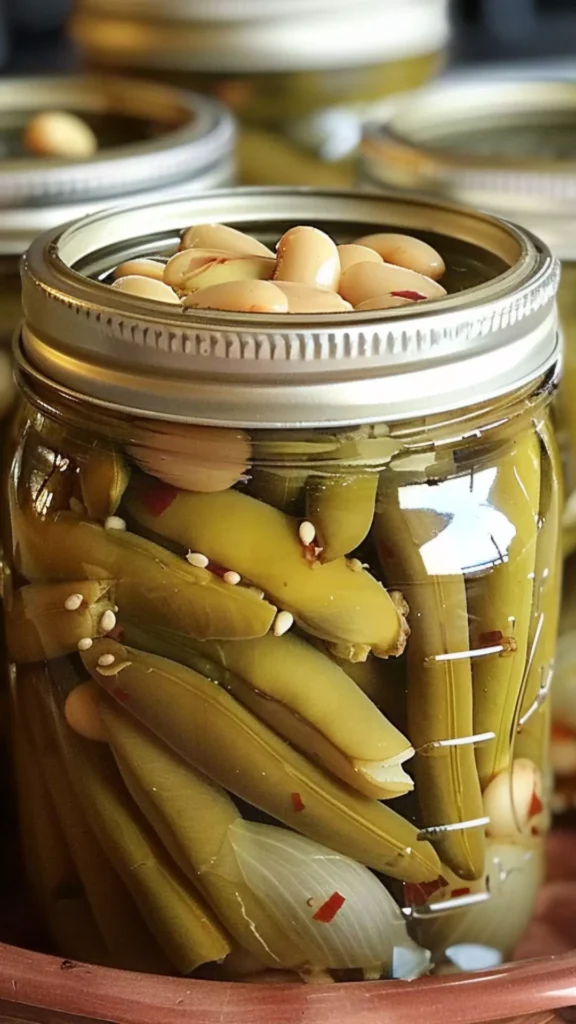
Step by Step Directions:
Step 1: Prepare the Brine
In a medium-sized saucepan, combine the distilled white vinegar, water, and salt. Bring the mixture to a gentle boil, ensuring the salt is completely dissolved.
Step 2: Blanch the Beans
While the brine is heating, prepare the green beans by trimming the ends. Blanch the beans in boiling water for 2 minutes, then promptly transfer them into an ice bath to halt the cooking process. This step helps retain the vibrant green color and ensures a crisp texture.
Step 3: Assemble the Jars
Sterilize glass jars and lids in boiling water. Place one sprig of dill and a peeled clove of garlic in each jar, followed by the blanched green beans. If you desire a touch of heat, sprinkle a pinch of red pepper flakes into each jar.
Step 4: Add the Brine
Carefully pour the hot brine over the green beans in each jar, ensuring they are fully submerged. Leave about ¼-inch headspace to allow for expansion during the pickling process.
Step 5: Seal and Store
Wipe the jar rims to remove any excess liquid or brine. Apply the lids snugly but not overly tight. Allow the jars to cool completely before placing them in the refrigerator or storage area. The pickled beans will be ready to enjoy in about 1 to 2 weeks.
Tips On Making old fashioned pickled beans:
– Choose fresh, crisp green beans to ensure optimal texture in the pickling process.
– Experiment with different vinegar types, such as cider vinegar, for subtle flavor variations.
– For a milder flavor, reduce the amount of red pepper flakes used.
– Allow the pickled beans to marinate for at least one week before consuming for a well-developed flavor.
– To avoid excessive softening, blanch the green beans for the suggested time and immediately transfer them to an ice bath.
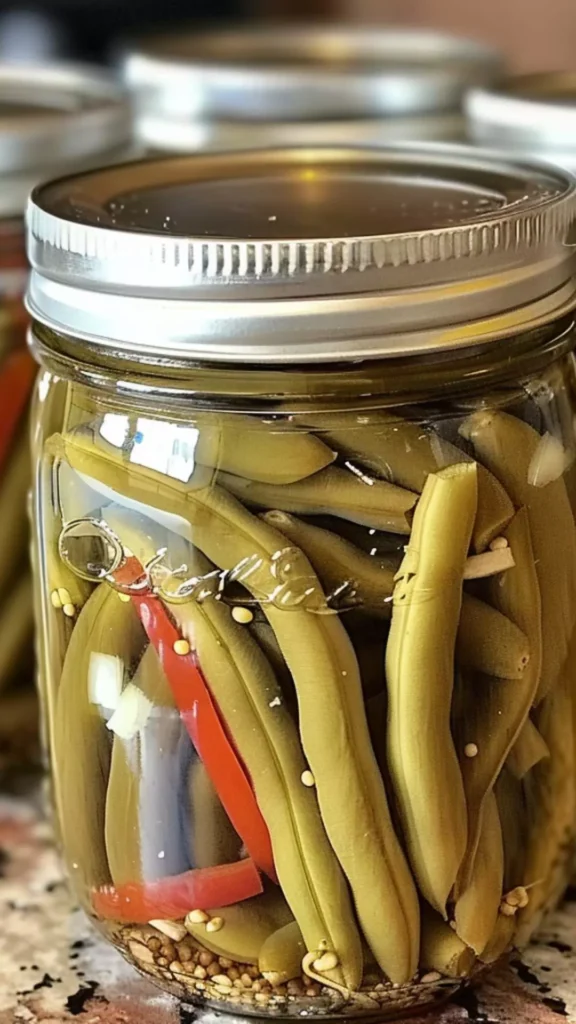
Nutrition Information:
Providing a healthy dose of vitamins and minerals, old-fashioned pickled beans are a guilt-free indulgence. When enjoying this tangy delicacy, remember that a 100-gram serving contains approximately 30 calories, 6 grams of carbohydrates, 2 grams of fiber, and a negligible amount of fat.
How Can I Store This old fashioned pickled beans?
Old-fashioned pickled beans can be stored in the refrigerator for up to 6 months. Ensure that the beans remain fully submerged in the brine to maintain their flavor and crispness. Improper storage can lead to degradation of quality, so always handle them with care.
If the items are not available in your kitchen, what are some substitute options for the ingredients?
1. Distilled White Vinegar: In the absence of distilled white vinegar, you can substitute it with apple cider vinegar or white wine vinegar for a slightly different flavor profile.
2. Garlic: If fresh garlic is unavailable, garlic powder can be used as a substitute. However, note that the flavor may not be as intense.
3. Dill: Fresh dill is essential for that distinct flavor, but in a pinch, dried dill can be used as an alternative. Adjust the amount according to personal preference, as dried dill tends to have a more concentrated taste.
4. Red Pepper Flakes: Those who prefer a milder taste can omit the red pepper flakes altogether. Alternatively, a sprinkle of cayenne pepper can substitute for a bit of heat.
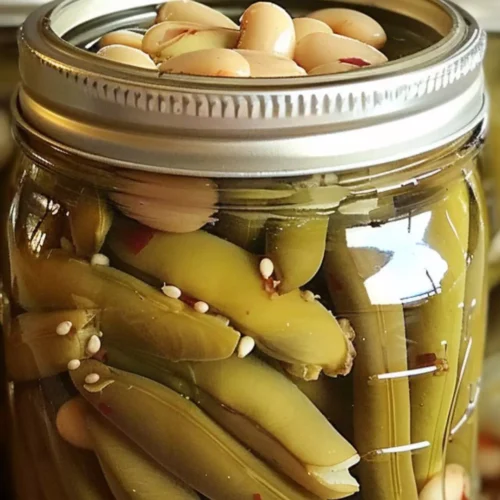
Old Fashioned Pickled Beans
Equipment
- Sharp knife and cutting board
- 6-8 quart stockpot
- 7 Pint (or 12-ounce) canning jars and new lids, regular or wide mouth
- Water bath canner and jar lifter
- Stainless steel canning funnel and ladle
Ingredients
- 2 cups Water
- 1 Clove Garlic peeled
- 2 ½ cups Distilled White Vinegar
- 6 large Sprigs Dill
- ¼ cup Salt
- 2 ½ pounds Fresh Green Beans
- ¾ teaspoon Red Pepper Flakes Optional
Instructions
- In a medium-sized saucepan, combine the distilled white vinegar, water, and salt. Bring the mixture to a gentle boil, ensuring the salt is completely dissolved.
- While the brine is heating, prepare the green beans by trimming the ends. Blanch the beans in boiling water for 2 minutes, then promptly transfer them into an ice bath to halt the cooking process. This step helps retain the vibrant green color and ensures a crisp texture.
- Sterilize glass jars and lids in boiling water. Place one sprig of dill and a peeled clove of garlic in each jar, followed by the blanched green beans. If you desire a touch of heat, sprinkle a pinch of red pepper flakes into each jar.
- Carefully pour the hot brine over the green beans in each jar, ensuring they are fully submerged. Leave about ¼-inch headspace to allow for expansion during the pickling process.
- Wipe the jar rims to remove any excess liquid or brine. Apply the lids snugly but not overly tight. Allow the jars to cool completely before placing them in the refrigerator or storage area. The pickled beans will be ready to enjoy in about 1 to 2 weeks.
Notes
- Choose fresh, crisp green beans to ensure optimal texture in the pickling process.
- Experiment with different vinegar types, such as cider vinegar, for subtle flavor variations.
- For a milder flavor, reduce the amount of red pepper flakes used.
- Allow the pickled beans to marinate for at least one week before consuming for a well-developed flavor.
- To avoid excessive softening, blanch the green beans for the suggested time and immediately transfer them to an ice bath.
Nutrition
Frequently Asked Questions:
Q1. Can I reuse the pickling brine for future batches?
Yes, you can reuse the pickling brine for additional batches of pickled beans. Simply strain the brine to remove any particles and boil it again to ensure the preservation of the flavors and maintain food safety standards.
Q2. How long does it take for the beans to fully pickle?
Old-fashioned pickled beans will typically reach their peak flavor after 1 to 2 weeks of marinating in the brine. However, you can start enjoying them as early as 24 hours after preparation.
Q3. Can I adjust the pickling brine to suit my taste preferences?
Absolutely! Adjusting the pickling brine is a great way to experiment and personalize the recipe. Altering the spices, acidity level, or salt content can help create a brine that perfectly complements your taste buds.
Q4. Can I use frozen green beans for this recipe?
While fresh green beans are ideal for pickling, you can substitute frozen green beans as well. However, ensure they are blanched before proceeding with the pickling process to maintain their texture and quality.
Q5. How should I serve old-fashioned pickled beans?
Old-fashioned pickled beans can be enjoyed in various ways. They make a delicious appetizer, a crunchy addition to salads, a tangy accompaniment to sandwiches, or even as an ingredient in your favorite pickle relish recipe.
Conclusion:
Embarking on this journey to rediscover old-fashioned pickled beans has been a delightful experience. The flavors, the history, and the art of preserving have all come together in this beloved culinary tradition.
So, dive into this recipe, relish the timeless taste, and pass it down to future generations. Let’s savor the nostalgia of the past with every crisp bite of these tangy delights – the old-fashioned pickled beans!

